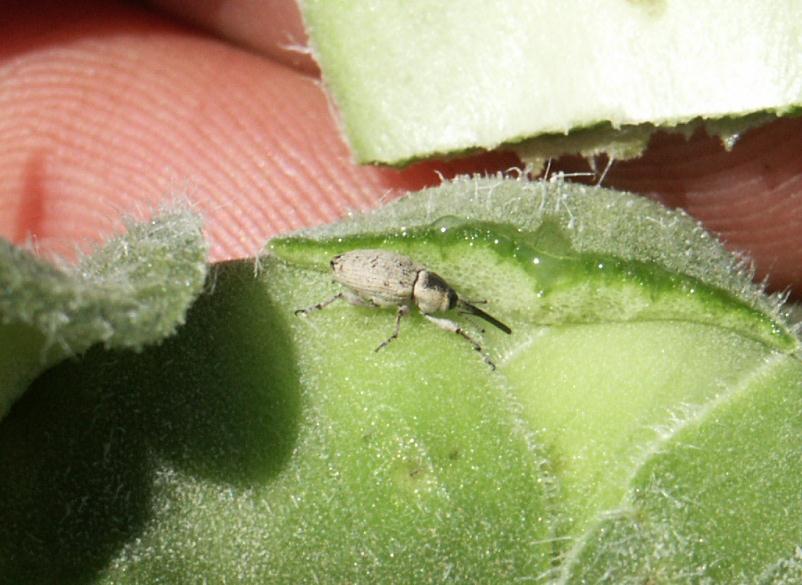Sunflower Insects
Gray Sunflower Seed Weevil, Smicronyx sordidus (Coleoptera: Curculionidae)

Adult gray seed weevil revealed under bract of flower bud.
(Photo credit: J.P. Michaud)
Identification
The gray seed weevil is about 8 mm (1/4 inch) long and pale gray, with a gently curving snout that is about half as long as the body. Adults can frequently be found hiding under the bracts of sunflower buds either prior to, or during, bloom. Larvae feeding within developing seeds and cause a galling response, leaving affected seeds swollen in appearance, but empty.
Life History and Behavior
There is only one generation a year, with adults emerging in late spring and typically entering sunflower fields as plants approach reproductive stages. Adults of both sexes can often be found on sunflower buds before they open, feeding on plant tissues underneath the bracts, but causing little damage. Females favor flowers in the late bud stage for oviposition, laying their eggs singly at the base of the developing seeds. Upon hatching, larvae bore into the seeds at their base, destroying the ovaries. At maturity, larvae exit the seeds and drop to the ground where they seek overwintering sites in the soil. Pupation occurs the following June.
Management
No economic threshold has been established for the gray seed weevil and it is generally considered a less serious pest than its cousin, the red seed weevil. One reason is that female fecundity is lower, meaning that each female lays fewer eggs and damages fewer seeds. Another reason is that postharvest downgrading is less of a risk from gray seed weevil infestation because galled seeds are typically removed during most standard processes of seed theshing and cleaning, whereas this is not true for seeds infested by red seed weevil. Consequently, yield losses caused by gray seed weevil are difficult to estimate and easily go unnoticed. Thresholds calculated for red seed weevil are sometimes used for gray seed weevil, but since insecticide treatments must target adults before the eggs are laid, control of gray seed weevil requires pesticide applications prior to bloom, when about 10-15 percent of plants have reached the R4 stage. This is not an attractive proposition when growers must also budget for the likelihood of a later spray for sunflower moth and/or red seed weevil. If treatment is judged necessary, select materials registered for red seed weevil and follow the same instructions.
More detailed information on the gray seed weevil can be found in KSRE publication MF3129.
Please refer to the most recent Sunflower Insect Management Guide for specific control recommendations.
Page last updated 04/01/2014 by J.P. Michaud.